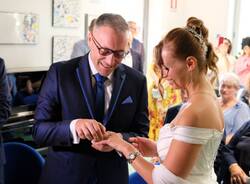Treating haemophilia with gene therapy
At the Polyclinic Hospital in Milan, for the first time in Italy, a patient has undergone an experimental treatment for this rare disease

Three infusions per week may be necessary for life to treat severe forms of haemophilia.
This rare genetic disease, which affects 5000 people in Italy and, put simply, consists of a blood defect that prevents coagulation, can lead to bleeding that may be fatal.
At the Polyclinic Hospital in Milan, the first gene therapy treatment in Italy, to treat a patient with severe haemophilia A has just been completed; as a result, he will not require the frequent infusions, for a number of years, and his blood will coagulate as anyone else’s does. This will have a huge impact on his quality of life.
Haemophilia is a hereditary defect caused by the absence of one of the proteins involved in coagulation. The lack of factor VIII causes haemophilia A, and lack of factor IX causes haemophilia B.
The patients affected experience episodes of bleeding, both spontaneous and due to trivial traumas; for haemophiliacs, even an ordinary game of football, a bike ride, or just shaving without due attention can become dangerous.
To date, it has been possible to prevent this kind of bleeding with infusions, which entail injecting into the patient factors VIII or IX, which he or she cannot produce alone. These factors, which can be obtained from the plasma of a donor or recombined (synthesised in the laboratory using biotechnologies), are infused preventively, to halt damage to the joints, but also to reduce the frequency of the bleeding.
Unfortunately, to make coagulation work normally, these infused factors need to be administered regularly, even up to 3 times a week, for life, which is one of the main reasons why patients, particularly children and adolescents, refuse or stop the treatment.
In contrast, gene therapy is a technique that exploits inactivated viruses (i.e. which have been made harmless) as DNA transporters to ‘correct’ a genetic defect. In haemophilia, as the patient’s DNA has ‘errors’ that prevent the correct production of the factors necessary for coagulation, gene therapy acts in such a way as to insert the correct DNA into the patient, thus restoring the function of factors VIII and IX.
This is an extremely delicate and complex technique, which has already been used to treat a very small number of other diseases (for example, ADA-SCID, which is also known as ‘bubble baby’ disease’), but this is the first time in Italy that it has been used for haemophilia.
“In the last 10 years, considerable progress has been made to benefit haemophilia patients,” explained Silvano Bosari, scientific director of the Polyclinic in Milan, “but the most innovative therapy that has proven to be able to transform the treatment of haemophilia is gene therapy. The results of our clinical studies have shown that a single infusion of this therapy can enable a patient with severe haemophilia to reach levels of factor VIII and factor IX that are almost within the norm and for long periods of time, even for some years.”
“The first patient was treated at the beginning of November,” added Flora Peyvandi, Director of General Medicine, Haemostasis and Thrombosis at the Polyclinic, and head of the clinical study, “and today, almost 4 weeks after the infusion, he is in good condition and is leading a regular life, without any particular problems. The staff at the “Angelo Bianchi Bonomi” Haemophilia Centre, in collaboration with several other operating units of the hospital, took part in the organisation of all phases of the procedure, and are monitoring the patient on a weekly basis.”
“Our hospital treats about one thousand patients with severe or moderate haemophilia, which is the largest record of cases in Italy,” concluded Ezio Belleri, General Director of the Polyclinic. “This gene therapy is a record, which entailed the perfect teamwork of over 20 experts from different operating units of ours, from medical internists to haematologists, nurses, pharmacists and anaesthetists, and soon the study will be extended to include immunologists and hepatologists. I’m sure that this is only the start of using of modern medications in rare diseases, for which, the Polyclinic is a perfect point of reference.”
Meanwhile, the first patient is continuing his periodic checks: the experts must verify that the production of factor VIII and its function are sufficient for correct coagulation. In the meantime, however, he can enjoy everyday life, without having to worry about all of those infusions, and with the knowledge he is the first patient to be involved in this genuine revolution in haemophilia.
TAG ARTICOLO
La community di VareseNews
Loro ne fanno già parte
Ultimi commenti
robertolonate su Il Natale che non si vede
robertolonate su Il Natale che non si vede
Alessandro Zanzi su A Varese Confcommercio chiede la sospensione dei lavori della ciclabile in viale Belforte, il Comune fissa un sopralluogo
Ettore S su Pista ciclabile di Viale Belforte a Varese: Fiab Varese plaude alla realizzazione
GrandeFratello su Pista ciclabile di Viale Belforte a Varese: Fiab Varese plaude alla realizzazione
brupaoli su Gli orari del Frecciarossa da Milano Malpensa a Venezia e Udine




















Accedi o registrati per commentare questo articolo.
L'email è richiesta ma non verrà mostrata ai visitatori. Il contenuto di questo commento esprime il pensiero dell'autore e non rappresenta la linea editoriale di VareseNews.it, che rimane autonoma e indipendente. I messaggi inclusi nei commenti non sono testi giornalistici, ma post inviati dai singoli lettori che possono essere automaticamente pubblicati senza filtro preventivo. I commenti che includano uno o più link a siti esterni verranno rimossi in automatico dal sistema.